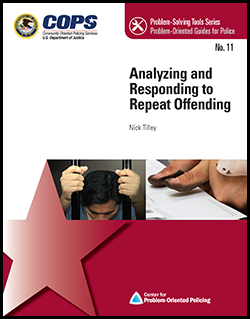Analyzing and Responding to Repeat Offending
Source
Center for Problem-Oriented Policing

A wide range of research converges on the following findings about criminal offenders:
- Some level of participation in criminal activity is normal, especially during adolescence and among males. Almost all citizens act dishonestly, commit crimes, and behave in antisocial ways at some point in their lives. Most will have committed more than one crime.
- Most people offend infrequently and soon age out of committing crime. Involvement in criminal behavior peaks in adolescence (ages 14–17) and then generally fades rapidly.
- A much smaller number of persistent and prolific offenders are responsible for a substantial proportion of all crime. Roughly half the crimes committed can be attributed to those identified as prolific offenders. Males commit far more offenses than females do, but even among female offenders, a small percentage commits a hugely disproportionate number of the offenses.
That a small fraction of offenders commits a large fraction of crime may come as no surprise to most police officers. The breadth of low-levels of offending and the proportion of crime attributable to those involved in it may not be so widely understood.
